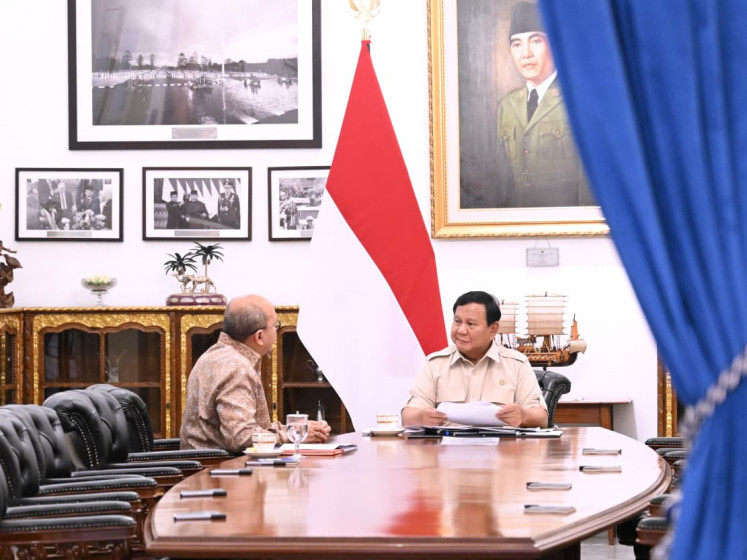Popular Reads
Top Results
Can't find what you're looking for?
View all search resultsPopular Reads
Top Results
Can't find what you're looking for?
View all search resultsMt. Sinabung erupts again, more evacuate
Mount Sinabung in North Sumatra erupted again Monday, with volcanologists calling this latest one stronger than Sunday’s eruption, while future eruptions are said to be difficult to predict
Change text size
Gift Premium Articles
to Anyone
M
ount Sinabung in North Sumatra erupted again Monday, with volcanologists calling this latest one stronger than Sunday’s eruption, while future eruptions are said to be difficult to predict.
Angry rumblings: Mount Sinabung spews smoke in Suka Nalu village, Tanah Karo, North Sumatra, on Monday. The volcano that erupted for the first time in four centuries on Sunday spewed fresh plumes of smoke early Monday morning, causing panic in nearby villages and delaying local flights, officials said. Reuters/Tarmizy Harva
Monday’s eruption prompted more residents to flee the area.
Officials of the Karo administration regency, where the volcano is located, say the number of residents evacuated from four districts had reached around 29,000.
They are being housed in 20 shelters. Some were reported to be in poor health, mostly due to respiratory illnesses and pneumonia.
The Indonesian Red Cross (PMI) said it would establish two public kitchens to feed 2,000 people per day starting Tuesday, for five days.
“That will cater for 10,000 people in total,” PMI official Aulia Arriani said in Jakarta.
The recent eruption has also prompted US Consul General Stanley Harsha to express concern.
“We express our regrets to the victims of this natural disaster and our resolve to stand with the government and people of Indonesia during such crises,” Harsha said in a release made available to The Jakarta Post.
The US, he said, had offered US$50,000 in assistance to the victims, in the form of non-food aid donated through the PMI.
The mass exodus of residents has paralyzed the economy of the areas around the mountain slopes. The displaced residents have been forced to make their way to nearby Kabanjahe and Brastagi in Karo regency and as far away as Langkat regency.
Karo regency secretary Makmur Ginting said more than 10,000 people were forced to abandon their homes on Monday.
The Volcanology and Geological Disaster Mitigation Agency (PVMBG) said the eruption that took place at 6:30 a.m. on Monday was bigger compared to that on Sunday.
PVMBG head Surono said the intensity of the Mt. Sinabung eruption on Monday could be measured from the height of the thick smoke it emitted.
“The altitude of the smoke today reached more than 2,000 meters from the crater surface compared to the eruption on Sunday [when the ash plume reached 1,500 meters],” Surono said Monday.
He said his agency would inform the local administration about raising the alert status if it became aware of the possibility of a bigger eruption.
He advised residents to carefully heed the volcano’s alert status.
Jonathan Tarigan from the North Sumatra branch of the Indonesian Geologists Association estimated that Mt. Sinabung’s eruption energy on Monday was triggered by pressurized steam.
He said rain had fallen in areas around Mt. Sinabung, entered the crater and reached the heat source inside the volcano that triggered pressurized steam.
Asked about the tremor that resembled a quake felt by residents during the eruption, Jonathan said it was possible the clogged crater was pushed by steam, causing the tremor.
He added he was concerned the eruption might serve as a sign of a looming massive quake in Karo
regency.
He cited the Mt. Talang eruption in West Sumatra in 2005 that was followed by two massive quakes in 2006 and 2009.
He said Karo regency was previously rocked by a massive 7.2-magnitude quake in 1936, which killed 19 people.
In Bandung, PVMBG official in charge of monitoring volcanoes Hendrasto called the event a rare volcanic explosion that defied predictions.
He said a PVMBG team had not yet installed a seismograph to detect possible eruptions when the first eruption occurred Sunday.
Hendrasto said the volcano had hardly been monitored since its last known eruption around 1600.
“No single human has records on when it erupted.”
“We have been too preoccupied” monitoring several other, more active volcanos, he added.
He said he could not predict if Mt. Sinabung would remain active because the potency of the magma underneath it was unknown.
— Yuli Tri Suwarni contributed to the story from Bandung.










